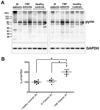Familial Mediterranean fever with a single MEFV mutation: where is the second hit?
- PMID: 19479870
- PMCID: PMC2753538
- DOI: 10.1002/art.24569
Familial Mediterranean fever with a single MEFV mutation: where is the second hit?
Abstract
Objective: Familial Mediterranean fever (FMF) has traditionally been considered an autosomal-recessive disease; however, it has been observed that a substantial number of patients with clinical FMF possess only 1 demonstrable MEFV mutation. The purpose of this study was to perform an extensive search for a second MEFV mutation in 46 patients diagnosed clinically as having FMF and carrying only 1 high-penetrance FMF mutation.
Methods: MEFV and other candidate genes were sequenced by standard capillary electrophoresis. In 10 patients, the entire 15-kb MEFV genomic region was resequenced using hybridization-based chip technology. MEFV gene expression levels were determined by quantitative reverse transcription-polymerase chain reaction. Pyrin protein levels were examined by Western blotting.
Results: A second MEFV mutation was not identified in any of the patients who were screened. Haplotype analysis did not identify a common haplotype that might be associated with the transmission of a second FMF allele. Western blots did not demonstrate a significant difference in pyrin levels between patients with a single mutation and those with a double mutation; however, FMF patients of both types showed higher protein expression as compared with controls and with non-FMF patients with active inflammation. Screening of genes encoding pyrin-interacting proteins identified rare mutations in a small number of patients, suggesting the possibility of digenic inheritance.
Conclusion: Our data underscore the existence of a significant subset of FMF patients who are carriers of only 1 MEFV mutation and demonstrate that complete MEFV sequencing is not likely to yield a second mutation. Screening for the set of the most common mutations and detection of a single mutation appears to be sufficient in the presence of clinical symptoms for the diagnosis of FMF and the initiation of a trial of colchicine.
Figures




Comment in
-
Changing concepts in familial Mediterranean fever: is it possible to have an autosomal-recessive disease with only one mutation?Arthritis Rheum. 2009 Jun;60(6):1575-7. doi: 10.1002/art.24565. Arthritis Rheum. 2009. PMID: 19479854 No abstract available.
References
-
- Kastner DLAI. 15 ed. Philadelphia: Lippincott Williams and Wilkins; 2005. Intermittent and periodic arthritis syndromes.
-
- Touitou I, Sarkisian T, Medlej-Hashim M, Tunca M, Livneh A, Cattan D, et al. Country as the primary risk factor for renal amyloidosis in familial Mediterranean fever. Arthritis Rheum. 2007;56(5):1706–1712. - PubMed
-
- The International FMF Consortium. Ancient missense mutations in a new member of the RoRet gene family are likely to cause familial Mediterranean fever. Cell. 1997;90(4):797–807. - PubMed
-
- The French FMF Consortium. A candidate gene for familial Mediterranean fever. Nat Genet. 1997;17(1):25–31. - PubMed
-
- Centola M, Wood G, Frucht DM, Galon J, Aringer M, Farrell C, et al. The gene for familial Mediterranean fever, MEFV, is expressed in early leukocyte development and is regulated in response to inflammatory mediators. Blood. 2000;95(10):3223–3231. - PubMed
Publication types
MeSH terms
Substances
Grants and funding
LinkOut - more resources
Full Text Sources

